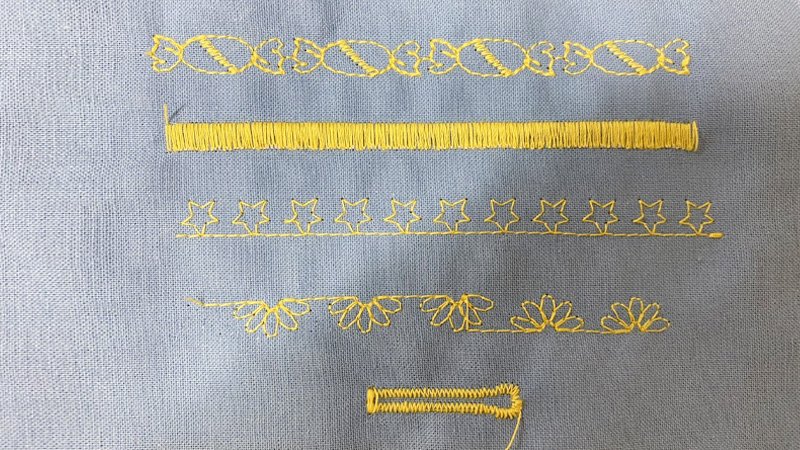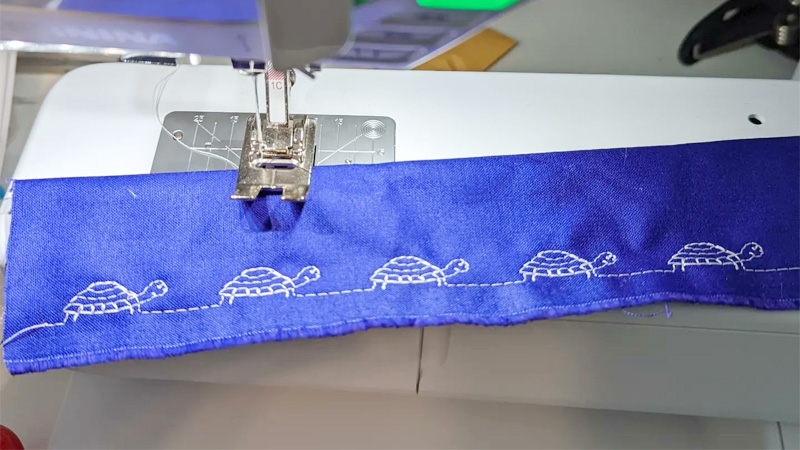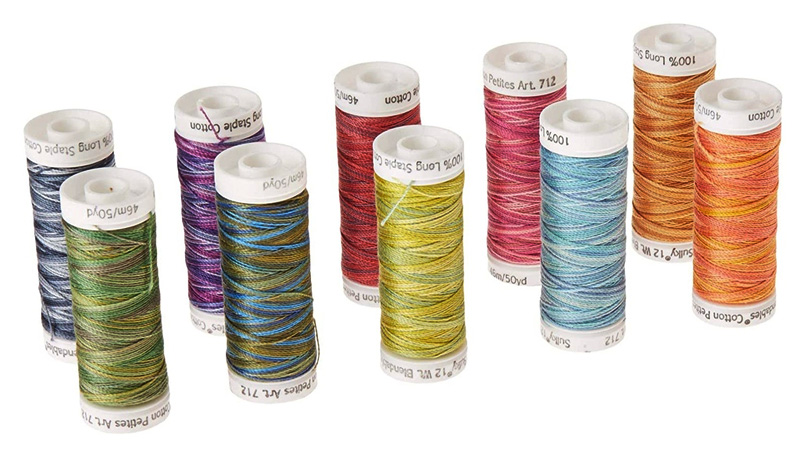Sewing is not just about functionality; it’s an art form that allows you to infuse your creativity into every stitch. One way to add a touch of elegance, charm, or personality to your sewing projects is by incorporating decorative machine stitches.
Whether you’re a seasoned sewist or a beginner looking to expand your horizons, this guide will take you on a journey through the world of decorative stitches.
In this comprehensive exploration, we will showcase decorative machine stitches – examples & tips. Each stitch has its unique character and application, making them ideal for embellishing garments, quilts, home decor, and more.
Additionally, we’ll provide you with valuable tips and techniques to make the most of these stitches, ensuring your creations stand out as true works of art.
So, dust off your sewing machine, gather your materials, and let’s dive into the enchanting realm of decorative machine stitches, where your imagination knows no bounds.

Decorative Machine Stitches – Examples & Tips
One of the most delightful ways to embellish your sewing projects is by incorporating decorative machine stitches. These stitches can add intricate patterns, textures, and unique flair to your creations. In this comprehensive guide, we will explore various decorative machine stitches.
Examples of Decorative Machine Stitches
Satin Stitch and Zigzag Stitch
The satin stitch is a dense, smooth stitch that creates a polished, satin-like finish. It’s perfect for outlining and filling in shapes, monogramming, or adding intricate details.
Zigzag stitches are versatile and can be adjusted in width and length. They’re great for finishing fabric edges, creating decorative seams, and adding texture.
Blanket Stitch and Chain Stitch
The blanket stitch resembles hand embroidery and is often used to finish the edges of blankets, appliqué work, or as a decorative border.
Chain stitches create a linked, looped pattern and are excellent for outlining shapes or creating decorative borders. They can be made in a single or double chain.
Feather Stitch and Cross Stitch
Feather stitches resemble delicate feathers and are perfect for adding a whimsical, organic touch to your projects. They’re often used in embroidery and heirloom sewing.
Cross stitches mimic traditional hand cross-stitch embroidery. They’re ideal for adding a rustic or folk-art feel to your sewing.
Decorative Satin Stitch Alphabet and Scallop Stitch
Many sewing machines offer built-in decorative alphabets that allow you to create personalized monograms, names, or messages with intricate satin stitching. Scallop stitches create a series of semi-circular shapes, perfect for decorative edges on hems, cuffs, and collars.
Candlewicking Stitch and Triple Stitch
Candlewicking stitches imitate the look of candlewicking embroidery, characterized by thick, raised lines. They add a vintage touch to your projects.
Triple stitches are bold and decorative. They create a triple row of stitching and are often used for topstitching or decorative seams.
Tips for Using Decorative Machine Stitches
Choose the Right Thread
Opt for thread colors that complement your fabric and project. Metallic, variegated, or contrasting threads can create stunning effects. Before stitching on your main project, test the decorative stitch on a scrap piece of fabric to ensure it looks as you envisioned and that the tension is correct.
Stitch Length and Width
Adjust the stitch length and width to achieve your desired look. Experiment with different settings to see how they affect the stitch.
For intricate or delicate fabrics, consider using stabilizers to prevent puckering or stretching while stitching. Tear-away or wash-away stabilizers are popular choices.
Mark Your Design
Use fabric markers or chalk to mark the design or pattern you want to follow. Clear markings will help you stay on track.
Keep a steady hand and practice stitching along marked lines to maintain even spacing and create clean, polished results.
Combine Stitches
Don’t limit yourself to using a single decorative stitch. Combine different stitches to create unique patterns and textures. Adjust the thread tension as needed. Tighten it if the stitches are loose or looser if the fabric is puckering.
Backstitch at the Beginning and End
Always backstitch at the beginning and end of your decorative stitching to secure the threads. Regularly clean and oil your sewing machine to ensure it operates smoothly when using decorative stitches.
Decorative stitching can be time-consuming, especially for intricate patterns. Take your time to achieve the best results.
What Are the Applications of Decorative Machine Stitches?

Decorative machine stitches are incredibly versatile and can be used in various applications to enhance the aesthetic appeal of your sewing projects. Here are some common applications of decorative machine stitches:
Garments and Quilting
Decorative stitches can elevate the look of clothing items. Use them along hems, cuffs, collars, and seams to add a touch of elegance or playfulness to dresses, shirts, and skirts.
Decorative stitches are often used in quilting to create eye-catching patterns and designs. They can be used for quilting the layers together, as well as for adding decorative borders and binding to quilts.
Home Decor and Accessories
Spruce up your home with decorative stitches on items like throw pillows, table runners, curtains, and bed linens. These stitches can add a personalized and stylish touch to your living space.
Add flair to accessories like bags, hats, belts, and scarves by incorporating decorative stitching. It’s a great way to make your accessories stand out and match your personal style.
Monogramming and Embroidery Hoop Art
Create personalized monograms on towels, napkins, and clothing items using decorative machine stitches. This adds a custom touch and makes items great for gifting.
Decorative stitches can be used to create intricate designs on fabric in embroidery hoops, turning them into unique pieces of art suitable for framing or display.
Kids’ Clothing and Pet Accessories
Decorative stitches can add fun and whimsy to children’s clothing. Use them on onesies, bibs, and rompers to create adorable and unique outfits.
Customize pet accessories such as dog collars, bandanas, and pet beds with decorative stitching to match your pet’s personality.
Holiday and Seasonal Decor
Decorative stitches are perfect for crafting holiday-themed decor items like stockings, tree skirts, and seasonal table runners. Delicate decorative stitches are often used in heirloom sewing, creating intricate and timeless designs on christening gowns, baby blankets, and more.
Costumes and Cosplay
Cosplayers often use decorative stitches to add intricate details to costumes, creating authentic looks for characters from various genres. Decorative stitches can secure patches and appliqué pieces in place while also adding a decorative element to your projects.
Doll and Toy Making
Give your handmade dolls and toys a unique and charming appearance by using decorative stitches for facial features, clothing details, and embellishments.
Create one-of-a-kind personalized gifts for family and friends by using decorative stitches to embellish items like tote bags, aprons, and kitchen towels.
Scrapbooking
Incorporate decorative stitches into your scrapbooking projects to attach photos, embellishments, and journaling cards for a creative and textured look.
These are just a few examples of how decorative machine stitches can be applied in your sewing projects. The versatility of these stitches allows you to unleash your creativity and transform everyday items into unique and eye-catching creations.
Whether you’re adding a touch of elegance or a playful twist, decorative stitches are a valuable tool for expressing your personal style in your sewing endeavors.
What Thread to Use for Decorative Machine Stitches?

Choosing the right thread for decorative machine stitches is essential to achieve the desired look and durability of your project. Here are some considerations when selecting thread for decorative stitching:
Thread Type
Use quality all-purpose polyester or cotton thread for most decorative stitches. These threads are strong, come in a wide range of colors, and are suitable for a variety of fabrics.
Special Threads
For added texture and visual interest, consider using specialty threads like metallic, variegated, or rayon threads. These threads can create stunning effects but may require adjustments to your machine’s tension settings.
Thread Weight
Thread weight refers to the thickness of the thread. Thicker threads (higher weight numbers) are more visible and can add depth to your decorative stitches. Thinner threads create delicate and subtle effects. Choose the thread weight that complements your project’s design.
Thread Color and Thread Brand
Select thread colors that enhance your project’s aesthetic. You can match the thread color to the fabric for a cohesive look or choose contrasting colors for a bold and eye-catching effect.
Quality matters when it comes to threads. Stick to reputable thread brands known for their strength and colorfastness to ensure the longevity of your decorative stitching.
Bobbin Thread and Tension Settings
Match the bobbin thread to the top thread to maintain a consistent appearance on both sides of your stitching. Using the same thread in the bobbin as on top is often a good practice.
Be prepared to make tension adjustments when using specialty threads or thicker threads. Testing on scrap fabric is crucial to find the right tension balance for your chosen thread.
Thread Storage and Thread Quality
Store your thread in a cool, dry place away from direct sunlight to prevent fading and damage. Proper storage helps maintain the thread’s quality over time.
Invest in high-quality thread to reduce the risk of thread breakage and ensure smooth stitching. Cheap or low-quality threads can lead to frustration and poor results.
Thread Lubrication
Some specialty threads, like metallic threads, benefit from lubrication to reduce friction and prevent breakage. Use a thread lubricant or conditioner as recommended by the thread manufacturer.
Remember that experimenting with different thread types and colors can yield unique and stunning results in your decorative stitching. Test your chosen thread on a scrap piece of fabric to ensure it works well.
By selecting the right thread, you can enhance the visual impact of your decorative machine stitches and create beautifully embellished sewing projects.
FAQs
Can I use decorative machine stitches on a basic sewing machine, or do I need a specialized machine?
You can use decorative machine stitches on a basic sewing machine; you don’t necessarily need a specialized machine. Most modern sewing machines, including basic models, come with a variety of decorative stitches built-in.
How do I choose the right decorative stitch for my project?
The choice of decorative stitch depends on your project’s design and the effect you want to achieve. Consider the fabric type, the purpose of the stitch (e.g., embellishment or functional), and your personal style.
Can I use decorative stitches on thick or heavy fabrics?
You can use decorative stitches on thick or heavy fabrics, but you may need to adjust your machine’s settings, such as stitch length and tension, to accommodate the fabric’s thickness. Using the appropriate needle size for heavy fabrics can also help achieve clean results.
What do I do if my thread keeps breaking while using decorative stitches?
Thread breakage can occur for various reasons, including incorrect tension settings, a dull needle, or using low-quality thread. Start by checking your machine’s tension settings, ensuring your needle is sharp, and using high-quality thread.
Can I combine different decorative stitches in one project?
Yes, you can combine different decorative stitches in a single project to create unique patterns and textures. Mixing stitches can add complexity and visual interest to your work.
Experiment with stitch combinations on a scrap piece of fabric to see which combinations work well.
Conclusion
Decorative machine stitches are a powerful tool in the world of sewing, allowing you to add style, flair, and individuality to your projects. Throughout this guide, we’ve explored a range of these stitches, each with its unique charm and versatility.
As you embark on your creative sewing journey, remember that practice is key to mastering these stitches. Experiment with different thread colors, fabrics, and stitch combinations to achieve the look and feel you desire.
By incorporating these stitches into your sewing repertoire, you can elevate your projects from ordinary to extraordinary. Whether you’re embellishing garments, quilts, or home decor items, the artistry of decorative machine stitches adds a personal touch.
So, go ahead and explore, experiment, and enjoy the wonderful world of decorative machine stitches. Your sewing creations will not only be functional but also true works of art that reflect your creative spirit and skill.
Leave a Reply